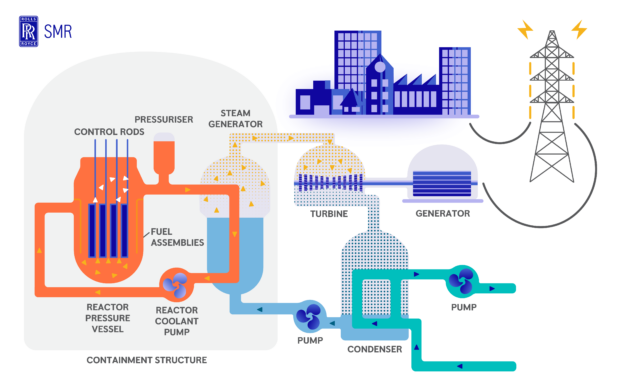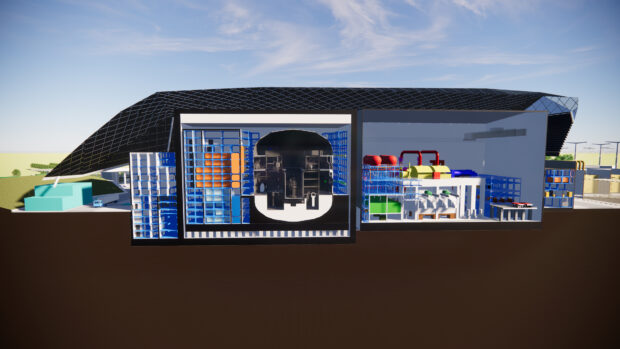
The Environment Agency’s New Reactors Assessment Team is leading the assessment of the Rolls-Royce SMR nuclear power station design. Andrew Pynn, Senior Advisor for the project, highlights the benefits of generic design assessment (GDA) and what happens next for this innovative new design.
New nuclear power stations are an important part of the government’s plans for generating secure low carbon energy. Just last week the government launched its ‘Powering Up Britain’ plan and ‘Great British Nuclear’ which will start to deliver the ambition to build up to 24GWe of nuclear capacity by 2050.
At the Environment Agency and Natural Resources Wales, the work delivered by our nuclear regulators is all about protecting communities and the environment. We’ve been looking at the Rolls-Royce SMR design to determine if it is environmentally acceptable for England and Wales.
After a year of learning about this new design and reviewing information provided by Rolls-Royce SMR Ltd, we’ve completed the preparatory step of our Generic Design Assessment and declared that the company is ready to start Step 2 today.
Working in partnership
The UK’s nuclear regulators work together, assessing designs at an early stage, before construction begins. Doing it early means we can spot any design issues that might impact on the environment and ask Rolls-Royce SMR Ltd’s designers to address them.
The Office for Nuclear Regulation (ONR) cover the safety and security whilst we and Natural Resources Wales (NRW) focus on protection of the environment and radioactive waste.
The regulators have set up a joint programme office to help deliver the GDA and our teams work together in person and virtually as part of a single project. Our communications and engagement with stakeholders is also joined up and we’ve set up joint webpages to provide information about GDA.

What happens in Step 2?
The GDA process has up to 3 steps, with our assessment getting more detailed as we progress. Now we’ve moved to Step 2 our team of nuclear regulators and scientists will be scrutinising even more information from Rolls-Royce SMR Ltd, identifying issues and highlighting any concerns we have. Step 2 is when the first technical assessment takes place and we focus on what features and arrangements are in place to protect the environment. This includes looking at how the design can be optimised to reduce the amount of radioactive waste produced and how that waste is managed and disposed of. We meet regularly with the company and it’s at these meetings where we talk thorough what we’ve found and make sure the Rolls-Royce engineers understand our expectations.

Tell us and the company what you think
Now we’ve launched Step 2 it’s time for the public and stakeholders to get involved. Engagement with communities is important to us. Whilst we don’t yet know where this reactor design could be located, Rolls Royce SMR Ltd has highlighted some sites it is interested in so we’ll start to focus our engagement initially in those areas. We also want to hear from engineers, academics, environmental groups, NGOs and others who are interested in nuclear reactor designs and their impact on the environment.
So how can you get involved? When we start a new GDA we ask the reactor design company to set up a ‘comments process’. This includes launching a website, providing information and asking for feedback on the design and information provided. Have a look at Rolls-Royce SMR Ltd’s new website and consider making a comment. We’ll see all your questions and comments, and the answers provided by the company. Your comments could help inform our assessments.
We’ll also hold a public consultation later in the process, if we go into Step 3 of the GDA.
Read the reports including a summary targeted at a non technical audience!
Contact us for more information about this GDA. nuclear@environment-agency.gov.uk
All images provided by Rolls-Royce SMR Ltd

24 comments
Comment by George Davies posted on
We must simply get on with this project. What other nation would allow such delays and cause its national champion to face such uncertainty?
Comment by Ewen Melling posted on
Consultation is right and proper, provides safeguards for the public and environment. We have a problem in this country in that we spend an excessive amount of time talking, racking up costs and allowing our competitors to in this case catch up. HS2 had many faults and one of them was a lack of action, don’t do the same with this important project.
Comment by Jeannette Dennis posted on
These small reactors are a brilliant and innovative. What is wrong with the government who keeps seeking foreign interest when we have the answers right here in the UK. For goodness sake let’s get started on this project.
Comment by David McCluskey posted on
These are NOT small reactors. Rolls Royce might label them as SMRs but they are anything but. Rolls-Royce SMR Ltd’s are 470 MW output. That is the equivalent of the AGRs at Hartlepool and Heysham 1 both of which are massive installations, There are few existing nuclear licensed sites in the UK and most of them are already spoken for. The hurdles to get over in order to get a virgin site licensed are very challenging indeed. The local and environmental opposition will be huge. Another problem is that they can't be sprinkled around the country but will need to located close to a completely reliable source of back-up cooling i.e. the coast.
Comment by Joshua Johnson posted on
For a government that believes we are in a 'climate emergency' they are painfully slow and reluctant to pursue the only realistic option to meet our energy needs.
The public investment is chump change relatively speaking, the regulators seem more interested in hearing from activist groups campaigning against nuclear energy than anyone who has relevant background and knowledge in the field.
Meanwhile SMR efforts in other nations are overtaking RRs efforts. Once again history repeats itself and British engineers are left behind the curve thanks to a feckless govt too short-sighted to see the benefits of new and innovative technology.
Comment by Les Jones posted on
We must proceed 2 support rr smr with all the resources possible , ensuring that the project is safe and economically viable.
Comment by Simon P David posted on
I’m sorry this seems incredibly slow. And why exactly should comments from NGOs “inform your assessment”? GDA is supposed to be a technical review the product of not a four year talking shop - leave political debate to parliament please. We’d quite like the lights to stay on.
Comment by Gary Proudfoot posted on
I believed in nuclear power 50 years ago, enough to take a doctorate in nuclear physics, but then saw no future in it. I watched other countries such as India overtake the UK in ongoing development of nuclear technology seeing it as a necessary part of future energy supply. The world is resource limited. The modular design and Gen 4 technologies are at last revitalising the landscape but young people need to buy into it. It is tremendous that SMR technology is moving forward but if the pace is too slow, and not marketed to today’s generation, they, like me will chose other fields rather than risk their future to chance. No matter how good it is, silent development of this technology is not enough if young people are to commit their careers to it.
Comment by Barry Clissold posted on
We have seen what has happened with Russia and gas supply.It is ridiculous for this government to be involving foreign companies in our basic resources. We must be in control of our own destiny. Even supposed friendly countries may have differing interests to UK in the future.
Comment by Roy Thorpe posted on
We've left the EU, or have supposedly left. Why oh why has the government thrown open the doors to outside (UK) competition. We have Rolls Royce, which has a proven record in mini-nukes on Subs. So, why doesn't the Government just get on with it and start INVESTING in BRITAIN before it's too late.
Comment by Sass Levi posted on
Please get on with it. Your teams are painfully slow. We need RR SMRs today. The slow pace risks more damage to the environment meanwhile, and puts our energy security at risk of falling into the hands of other countries competing in this area. Please support Rolls Royce, a flagship UK company, and don’t slow them down as they compete with others. We need 12 UK built SMRs around the country ‘tomorrow’. Not in 2035 !!
Comment by John Cowley posted on
The government really need to move quickly on approving these new SMR nuclear power stations. The UK desperately needs to be energy independent, the quicker we are energy independent the better, once we achieve this, it will be a win win for the UK! We should also be investing in Hydro Generators, we are an island, so there are may places that we could install Hydro Generators. Why the power of the River Severn has not been harnessed to provide virtually free (once installed) energy, I will never know. Look at the benefits the Hoover dam has achieved since it was completed in 1936, 87 years of green energy. Why have the UK not harnessed Hydro energy, it would definitely be beneficial for the UK.
Comment by Frank Tulodziecki posted on
It is clear that SMR’s are an essential compliment to green renewable energy, if it were not for the waste element there would be no argument. As a parallel activity we need to consider how we minimise and dispose of nuclear waste, solutions other than burying it or piling it up in storage containers for the next generation to worry about. May be one for space x to shuttle waste to the moon and return back with Helium 3 or other rare earth minerals.
For now though we really have to get on with it and if we ever want to see Britain great again let’s not take the shortsighted penny pinching lowest price tender approach that gives this work away to a subsidised foreign company, lets show case what British engineering is capable of and become the place to come to for SMR’s and who knows what technology next!
Comment by James Green posted on
The focus of GBN is a competition of the 6 technology developers.
What we need is the site developers to be starting work too.
Otherwise we have a long drawn out process:
GDA 4 years
Site Developer Planning and receipt of Development Consent (6 years for Sizewell C)
First Spade in ground. Then presumably 30 months construction if claims from technology developers are to be believed.
So 12.5 years, 1 year shorter for RR as they are at stage 2 of GDA.
Comment by Suzi Filleul posted on
Is Rolls Royce going to provide their small nuclear reactors for Britain?
Comment by Marcus posted on
No, contact given to X-energy and Cavendish Nuclear, I hope the General Election eradicate this choice and keep our own power generators British for once.
Comment by Lee posted on
Are we still tied to EU rules and regulations because I cannot understand why the government has put out to tender Britain’s SMR’s foreign manufacturers? Do the right thing for once and support a world class homegrown British manufacturer, if not now, when? The British government has a track record of sabotaging British innovation, so don’t repeat past mistakes, otherwise the electorate will vote for an alternative party that supports British innovation.
Comment by Marcus posted on
When the current Government award the SMR to a company that does not even have a blue print of their design one has to ask what line of corruption or incompetence do we have again in our House.
Voting not red or blue this time I can guarantee.
Comment by Suzi posted on
Has there been any comment from the appropriate government department to explain this apparent fiasco? After all they are always banging on about supporting British business. Where else is the growth going to come from? They talk the talk but do not walk the walk.
No doubt money is at the bottom of this
Comment by Paul Fitzpatrick posted on
RR has a long proven record of safe, reliable, successful submarine PWRs. As the leading British contender for SMR roll-out can’t the Government appoint them as the sole suppliers and throw out the foreign competition (many on the shortlist don’t have a proven small reactor record). Let’s get on with this - do the due diligence and let’s get the RR SMRs rolled out. We need low carbon power now and SMRs are the ideal adjunct to wind, tidal and solar energy. Wake up UK Govt!
Comment by Tim Bennett-Odlum posted on
I would like to know where this fits in with the plans of the new Labour government. I believe we should speed up any approvals process for RR SMR and kick out the foreign competition and get these things built around the country as soon as possible, because without it we are stuffed as demand for electricity is set to sky rocket withAI and nobody wants `EDS solar farms and wind turbines all over our beautiful landscapes. Labour might t not care but we do. Any solar farms and wind turbines give us a reprocessing & environmental nightmare to deal at en d of life.has this been factored in to Labours plans.
Comment by GRAHAM WAGSTAFF MBE posted on
Surely this is a no brainer? Rolls Royce has been building small PWR's (Pressurised Water Reactors) for many years which have performed reliably and have proved to be literally "bomb proof". Their proposed SMR PWR is developed using the experience gained from the manufacture and through life support of the Royal Navy's Submarine PWRs. Some of the other companies short listed have no experience in small PWR design or manufacture. In addition, one has a very poor safety record. These suppliers should be immediately discarded so the the assessment teams can concentrate on the real contenders RR and Westinghouse (Westinghouse supply US Navy submarine PWRs). It should also be noted that the major pressure vessels of a RR SMR will probably be manufactured in the UK by Sheffield Forgemasters. Forgemasters is owned by the Ministry of Defence. Its time to get into gear, concentrate on the objective, reduce the consultation time and order a plant from company that can deliver working SMRs before 2030. Lets make the UK nuclear industry great again and lead the world.
Comment by Colin Fisher posted on
The country needs RR SMRs asap and we should fast track the due process sarga. We need to take some financial risk and support RR consortium to build the factories in parallel with the final stages of regulatory hurdels. We can do it,we did it with the covid vacine roll out and got many benefits.
Comment by GRAHAM WAGSTAFF MBE posted on
Have we missed the bus?
2 weeks ago, RRSMR and CEZ Group announced that they have gone into partnership to produce RRSMR’S for the Czech Republic. CEZ Group is a state-owned power generation and gas distribution company. CEZ Group has acquired a 20% stake in RRSMR making it their biggest shareholder. RRSMR CEO stated that they had to go to the Czech Republic because they were unable to get investment in the UK.
The parts for the RRSMR’S will be sourced in the Czech Republic. Work starts on the first reactor next year with the intention to build 3. Orders for RRSMRs from other European countries are at an advance stage of negotiation. All of the above brings the following questions to mind.
1. When the UK finally approves the RRSMR’S will their order book be full with orders from other, less bureaucratic countries?
2. Are the components being produced in the Czech Republic Primary (nuclear), secondary (steam generating plant) or site construction work?
3. How many skilled UK jobs have been lost to the Czech Republic?
4. Is the decision the shelve the building of the Scott’s Corner SMR plant because the work is going to the Czech Republic?
Thers’s an old saying in project management “if you want it bad you’ll get it bad”. Yes, there has to be due diligence but the UK government is taking the bureaucratic process to the extreme. If we carry on at this pace we will miss the bus.